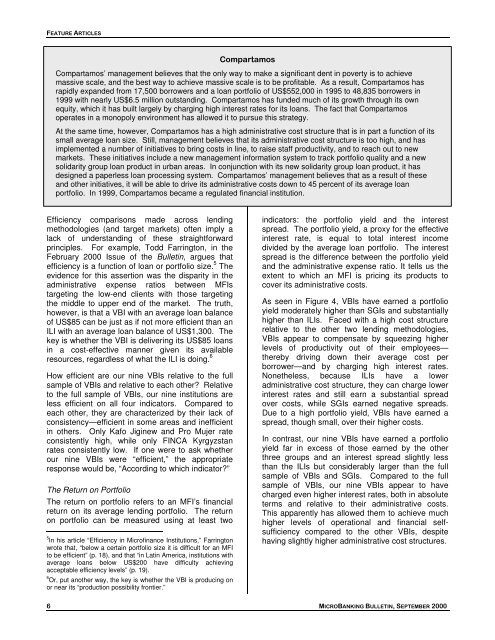MICROBANKING BULLETIN - Microfinance Information Exchange
MICROBANKING BULLETIN - Microfinance Information Exchange
MICROBANKING BULLETIN - Microfinance Information Exchange
You also want an ePaper? Increase the reach of your titles
YUMPU automatically turns print PDFs into web optimized ePapers that Google loves.
FEATURE ARTICLESCompartamosCompartamos’ management believes that the only way to make a significant dent in poverty is to achievemassive scale, and the best way to achieve massive scale is to be profitable. As a result, Compartamos hasrapidly expanded from 17,500 borrowers and a loan portfolio of US$552,000 in 1995 to 48,835 borrowers in1999 with nearly US$6.5 million outstanding. Compartamos has funded much of its growth through its ownequity, which it has built largely by charging high interest rates for its loans. The fact that Compartamosoperates in a monopoly environment has allowed it to pursue this strategy.At the same time, however, Compartamos has a high administrative cost structure that is in part a function of itssmall average loan size. Still, management believes that its administrative cost structure is too high, and hasimplemented a number of initiatives to bring costs in line, to raise staff productivity, and to reach out to newmarkets. These initiatives include a new management information system to track portfolio quality and a newsolidarity group loan product in urban areas. In conjunction with its new solidarity group loan product, it hasdesigned a paperless loan processing system. Compartamos’ management believes that as a result of theseand other initiatives, it will be able to drive its administrative costs down to 45 percent of its average loanportfolio. In 1999, Compartamos became a regulated financial institution.Efficiency comparisons made across lendingmethodologies (and target markets) often imply alack of understanding of these straightforwardprinciples. For example, Todd Farrington, in theFebruary 2000 Issue of the Bulletin, argues thatefficiency is a function of loan or portfolio size. 5 Theevidence for this assertion was the disparity in theadministrative expense ratios between MFIstargeting the low-end clients with those targetingthe middle to upper end of the market. The truth,however, is that a VBI with an average loan balanceof US$85 can be just as if not more efficient than anILI with an average loan balance of US$1,300. Thekey is whether the VBI is delivering its US$85 loansin a cost-effective manner given its availableresources, regardless of what the ILI is doing. 6How efficient are our nine VBIs relative to the fullsample of VBIs and relative to each other? Relativeto the full sample of VBIs, our nine institutions areless efficient on all four indicators. Compared toeach other, they are characterized by their lack ofconsistency—efficient in some areas and inefficientin others. Only Kafo Jiginew and Pro Mujer rateconsistently high, while only FINCA Kyrgyzstanrates consistently low. If one were to ask whetherour nine VBIs were “efficient,” the appropriateresponse would be, “According to which indicator?”The Return on PortfolioThe return on portfolio refers to an MFI’s financialreturn on its average lending portfolio. The returnon portfolio can be measured using at least two5 In his article “Efficiency in <strong>Microfinance</strong> Institutions,” Farringtonwrote that, “below a certain portfolio size it is difficult for an MFIto be efficient” (p. 18), and that “in Latin America, institutions withaverage loans below US$200 have difficulty achievingacceptable efficiency levels” (p. 19).6 Or, put another way, the key is whether the VBI is producing onor near its “production possibility frontier.”indicators: the portfolio yield and the interestspread. The portfolio yield, a proxy for the effectiveinterest rate, is equal to total interest incomedivided by the average loan portfolio. The interestspread is the difference between the portfolio yieldand the administrative expense ratio. It tells us theextent to which an MFI is pricing its products tocover its administrative costs.As seen in Figure 4, VBIs have earned a portfolioyield moderately higher than SGIs and substantiallyhigher than ILIs. Faced with a high cost structurerelative to the other two lending methodologies,VBIs appear to compensate by squeezing higherlevels of productivity out of their employees—thereby driving down their average cost perborrower—and by charging high interest rates.Nonetheless, because ILIs have a loweradministrative cost structure, they can charge lowerinterest rates and still earn a substantial spreadover costs, while SGIs earned negative spreads.Due to a high portfolio yield, VBIs have earned aspread, though small, over their higher costs.In contrast, our nine VBIs have earned a portfolioyield far in excess of those earned by the otherthree groups and an interest spread slightly lessthan the ILIs but considerably larger than the fullsample of VBIs and SGIs. Compared to the fullsample of VBIs, our nine VBIs appear to havecharged even higher interest rates, both in absoluteterms and relative to their administrative costs.This apparently has allowed them to achieve muchhigher levels of operational and financial selfsufficiencycompared to the other VBIs, despitehaving slightly higher administrative cost structures.6 <strong>MICROBANKING</strong> <strong>BULLETIN</strong>, SEPTEMBER 2000
















